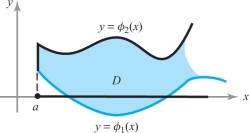Exercises for Section 16.4
In the first four exercises, evaluate the following integrals if they exist (discuss how you define the integral if it was not given in the text).
Question 16.96
\({\displaystyle\intop\!\!\!\intop\nolimits_{\! D}} \frac{\textstyle 1}{{\textstyle \sqrt{xy}}}\ {\it dA}\), where \(D=[0,1]\times [0,1]\)
Question 16.97
\({\displaystyle\intop\!\!\!\intop\nolimits_{\! D}} \frac{\textstyle1}{{\textstyle\sqrt{|x-y|}}}\,{\it dx}\,{\it dy}\), where \(D=\{(x,y)\mid 0\leq x\leq 1\), \(0\leq y\leq 1\), \(y\leq x\}\)
Question 16.98
\( {\displaystyle\intop\!\!\!\intop\nolimits_{\! D}}(y/x)\,{\it dx}\,{\it dy}\), where \(D\) is bounded by \(x=1,x=y\), and \(x=2y\)
Question 16.99
\({\displaystyle\int\nolimits^1_0}{\displaystyle\int\nolimits^{e^v}_0}\log x\,{\it dx}\,{\it dy}\)
Question 16.100
Let \(D = [0,1] \times [0,1]\). Let \(0 < \alpha < 1\) and \(0 < \beta < 1\). Evaluate: \[ \intop\!\!\!\intop\nolimits_{D} \frac{dx\, dy}{x^{\alpha}y^{\beta}}. \]
Question 16.101
Let \(D = [1, \infty) \times [1,\infty]\). Let \(1 < \gamma\) and \(1 < \rho\). Evaluate: \[ \intop\!\!\!\intop\nolimits_{D} \frac{dx\, dy}{x^{\gamma}y^{\rho}}. \]
346
Question 16.102
- (a) Evaluate \[ \intop\!\!\!\intop\nolimits_{D}\frac{\it dA}{(x^2+y^2)^{2/3}}, \] where \(D\) is the unit disk in \({\mathbb R}^2\).
- (b) Determine the real numbers \(\lambda\) for which the integral \[ \intop\!\!\!\intop\nolimits_{D}\frac{\it dA}{(x^2+y^2)^\lambda} \] is convergent, where again \(D\) is the unit disk.
Question 16.103
- (a) Discuss how you would define \({\intop\!\!\intop}_D f \ {\it dA}\) if \(D\) is an unbounded region—for example, the set of \((x,y)\) such that \(a\leq x< \infty\) and \(\phi_1(x)\leq y \leq \phi_2(x)\), where \(\phi_1 \leq \phi_2\) are given (Figure 16.24).
- (b) Evaluate \({\intop\!\!\intop}_D xy e^{-(x^2+y^2)}{\it dx}\,{\it dy}\) if \(x\geq 0,\) \(0\leq y\leq 1\).

Question 16.104
Using the previous exercise, integrate \(e^{-xy}\) for \(x\geq 0,1\leq y\leq 2\) in two ways. Assuming Fubini’s theorem can be used, show that \[ \int_{0}^{\infty}\frac{e^{-x}-e^{-2x}}{x}{\it dx}=\log 2. \]
Question 16.105
Show that the integral \[ \int^1_0\int^a_0(x/\sqrt{a^2-y^2})\,{\it dy}\,{\it dx} \] exists, and compute its value.
Question 16.106
Discuss whether the integral \[ \intop\!\!\!\intop\nolimits_{D}\frac{x+y}{x^2+2xy+y^2}{\it dx}\,{\it dy} \] exists where \(D=[0,1]\times [0,1]\). If it exists, compute its value.
Question 16.107
We can also consider improper integrals of functions that fail to be continuous on entire curves lying in some region \(D\). For example, by breaking \(D=[0,1]\times [0,1]\) into two regions, define and then discuss the convergence of the integral \[ \intop\!\!\!\intop\nolimits_{D}\frac{1}{\sqrt{|x-y|}}{\it dx}\,{\it dy}. \]
Question 16.108
Let \(W\) be the first octant of the ball \(x^2+y^2+z^2\leq a^2\), where \(x\geq 0,y\geq 0,z\geq 0\). Evaluate the improper integral \[ \intop\!\!\!\intop\!\!\!\intop\nolimits_{W}\frac{(x^2+y^2+z^2)^{1/4}}{\sqrt{z+(x^2+y^2+z^2)^2}}{\it dx}\,{\it dy}\,{\it dz} \] by changing variables.
Question 16.109
Let \(f\) be a nonnegative function that may be unbounded and discontinuous on the boundary of an elementary region \(D\). Let \(g\) be a similar function such that \(f(x,y)\leq g(x,y)\) whenever both are defined. Suppose \({\intop\!\!\intop}_Dg(x,y)\,{\it dA}\) exists. Argue informally that this implies the existence of \({\intop\!\!\intop}_Df(x,y)\,{\it dA}\).
Question 16.110
Use the previous exercise to show that \[ \intop\!\!\!\intop\nolimits_{D} \frac{\sin^2(x-y)}{\sqrt{1-x^2-y^2}}{\it dy}\,{\it dx} \] exists where \(D\) is the unit disk \(x^2+y^2\leq 1\).
Question 16.111
Let \(f\) be as in two exercises back and let \(g\) be a function such that \(0\leq g(x,y)\leq f(x,y)\) whenever both are defined. Suppose that \({\intop\!\!\intop}_Dg(x,y)\, {\it dA}\) does not exist. Argue informally that \({\intop\!\!\intop}_Df(x,y) \, {\it dA}\) cannot exist.
Question 16.112
Use the previous exercise to show that \[ \intop\!\!\!\intop\nolimits_{D}\frac{e^{x^2 + y^2}}{x-y}{\it dy}\,{\it dx} \] does not exist, where \(D\) is the set of \((x,y)\) with \(0\leq x\leq 1\) and \(0\leq y\leq x\).
Question 16.113
Let \(D\) be the unbounded region defined as the set of \((x,y,z)\) with \(x^2+y^2+z^2\geq 1\). By making a change of variables, evaluate the improper integral \[ \intop\!\!\!\intop\!\!\!\intop\nolimits_{D}\frac{{\it dx}\,{\it dy}\,{\it dz}}{(x^2+y^2+z^2)^2}. \]
Question 16.114
Evaluate \[ \int^1_0 \int^y_0 \frac{x}{y} {\it dx}\, {\it dy} \qquad\hbox{and}\qquad \int^1_0 \int^1_x \frac{x}{y} {\it dy}\, {\it dx}. \] Does Fubini’s theorem apply?
347
Question 16.115
In the seventeenth exercise of Section 15.2 we showed that \[ \int^1_0\!\! \int^1_0 \frac{x^2-y^2}{(x^2 +y^2)^2} {\it dy}\, {\it dx}\,\ne \int^1_0\!\!\int^1_0 \frac{x^2-y^2}{(x^2 +y^2)^2} {\it dx}\, {\it dy}. \] Thus, Fubini’s theorem does not hold here, even though the iterated improper integrals both exist. What went wrong?
Question 16.116
If \(0 \leq f(x,y) \leq g(x,y)\) for all \((x,y) \in D\), and the improper integral of \(g\) \[ {\intop\!\!\!\intop}_{D} g(x,y) \, {\it dx\, dy} \] exists, then \({\intop\!\!\intop}_{D} f(x,y) \, {\it dx\, dy}\) also exists. Use this fact and exercises 5 and 6 to argue that if \(0 < \alpha,\beta < 1\) and \(1 < \gamma,\rho\), then \[ {\intop\!\!\!\intop}_{D} \frac{{\it dx\, dy}}{x^{\alpha}y^{\beta} + x^{\gamma}y^{\rho}} \] exists, where \(D = [0, \infty) \times [0, \infty)\).
[HINT: Write \(D = D_1 \cup D_2\) and apply the fourteenth exercise above to each \(D_{i}\) separately.]